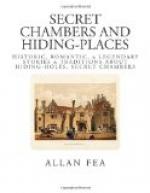Not many miles from Albourne stands Street Place, an Elizabethan Sussex house of some note. A remarkable story of cavalier-hunting is told here. A hiding-place is said to have existed in the wide open fireplace of the great hall. Tradition has it that a horseman, hard pressed by the Parliamentary troopers, galloped into this hall, but upon the arrival of his pursuers, no clue could be found of either man or horse!
The gallant Prince Rupert himself, upon one occasion, is said to have had recourse to a hiding hole, at least so the story runs, at the beautiful old black-and-white timber mansion, Park Hall, near Oswestry. A certain “false floor” which led to it is pointed out in a cupboard of a bedroom, the hiding-place itself being situated immediately above the dining-room fireplace.
A concealed chamber something after the same description is to be seen at the old seat of the Fenwicks, Wallington, in Northumberland—a small room eight feet long by sixteen feet high, situated at the back of the dining-room fireplace, and approached through the back of a cupboard.
Behind one of the large panels of “the hall” of an old building in Warwick called St. John’s Hospital is a hiding-place, and in a bedroom of the same house there is a little apartment, now converted into a dressing-room, which formerly could only be reached through a sliding panel over the fireplace.
The manor house of Dinsdale-on-Tees, Durham, has another example, but to reach it it is necessary to pass through a trap-door in the attics, crawl along under the roof, and drop down into the, space in the wall behind a bedroom fireplace, where for extra security there is a second trap-door.
[Illustration: BROUGHTON HALL, STAFFORDSHIRE]
[Illustration: ST. JOHN’S HOSPITAL, WARWICK]
Full-length panel portraits of the Salwey family at Stanford Court, Worcestershire (unfortunately burned down in 1882), concealed hidden recesses and screened passages leading up to an exit in the leads of the roof. In one of these recesses curious seventeenth-century manuscripts were found, among them, the household book of a certain “Joyce Jeffereys” during the Civil War.
The old Jacobean mansion Broughton Hall, Staffordshire, had a curious hiding-hole over a fireplace and situated in the wall between the dining-room and the great hall; over its entrance used to hang a portrait of a man in antique costume which went by the name of “Red Stockings.”
At Lyme Hall, Cheshire, the ancient seat of the Leghs, high up in the wall of the hall is a sombre portrait which by ingenious mechanism swings out of its frame, a fixture, and gives admittance to a room on the first floor, or rather affords a means of looking down into the hall.[1] We mention this portrait more especially because it has been supposed that Scott got his idea here of the ghostly picture which figures in Woodstock. A bona-fide hiding-place, however, is to be seen in another part of the mansion in a very haunted-looking bedroom called “the Knight’s Chamber,” entered through a trap-door in the floor of a cupboard, with a short flight of steps leading into it.




